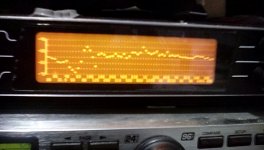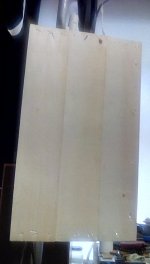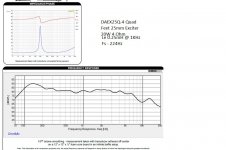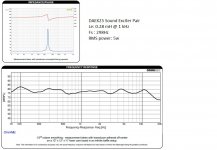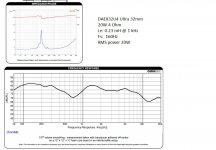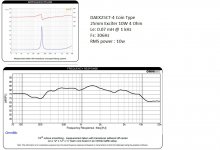I came across this table of damping factors the other day. Learnt there was such a thing as Panzerholz and Permali- wonders never cease.I have thought about buying Sorbothane many times, but never did.
Eric
I had to replace a leaking window in a caravan we bought recently, and I used butyl mastic (Bostik 5612). I have not found a damping figure for it, but its quite cheap, and I think would have good damping factor. It's very sticky, gooey and thick, and never sets or hardens. I also have some stick-on EPDM rubber window seal, which is hollow. I reckon if you could fill up the rubber tube with the mastic, you would have an effective (and not so messy) damper tape.
Can someone please direct me to the documents on the Tall Blondes? I looked at them before but I think I missed the paper on them.
Here it isCan someone please direct me to the documents on the Tall Blondes? I looked at them before but I think I missed the paper on them.
#1117 p56 Tall Story Build Notes
I think this is a good option for a panel subwoofer:https://patents.google.com/patent/JP2008109541A/en?oq=JP2008109541A
I just did a rough and ready response plot of the new three strip low quality ply.
the response looks pretty good to me all the way up to 20k even though the exciter is only stuck on with double sided tape.
the low end has the usual resonant hump but this time it is at about 80hz and falls like a brick at about 60hz.
The microphone was at about 30cm.
There is a little blip at about 1k which I suspect is a little exciter noise, which I will have to fix at a later date.
I've been playing them in conjunction with the art panel with the same panel materials and they work together well.
Obviously the art panel resonant hump goes down to 40hz which helps fill out the sound.
The efficiency of this material is quite amazing, I have not put it up against my large EPS panels yet but expect it to be quite close ?
I am now thinking of applying another strip, the last one, and seeing how it goes ?
Hopefully it won't fall apart ?
Steve.
the response looks pretty good to me all the way up to 20k even though the exciter is only stuck on with double sided tape.
the low end has the usual resonant hump but this time it is at about 80hz and falls like a brick at about 60hz.
The microphone was at about 30cm.
There is a little blip at about 1k which I suspect is a little exciter noise, which I will have to fix at a later date.
I've been playing them in conjunction with the art panel with the same panel materials and they work together well.
Obviously the art panel resonant hump goes down to 40hz which helps fill out the sound.
The efficiency of this material is quite amazing, I have not put it up against my large EPS panels yet but expect it to be quite close ?
I am now thinking of applying another strip, the last one, and seeing how it goes ?
Hopefully it won't fall apart ?
Steve.
Attachments
Could you please help in choosing exciter out of the below models which are available here. Attached the response graphs given in its data sheets.
DAEX25Q and DAEX32U are rated at 20w, and DAEX25 at 5w, and DAEX25CT at 10w
The more popular one DAEX25FHE is not available here and is out of stock.
Thinking of using them with Canvas panels running full range to start with.
One common thing in the data sheet graphs is that all the models have weaker top end / treble after around 10KHz. And for DAEX32U we have a dip at 700Hz. Do we see similar behavior when used with plywood or canvas panels
DAEX25Q and DAEX32U are rated at 20w, and DAEX25 at 5w, and DAEX25CT at 10w
The more popular one DAEX25FHE is not available here and is out of stock.
Thinking of using them with Canvas panels running full range to start with.
One common thing in the data sheet graphs is that all the models have weaker top end / treble after around 10KHz. And for DAEX32U we have a dip at 700Hz. Do we see similar behavior when used with plywood or canvas panels
Attachments
The language here is difficult to understand, but from the diagram, I had a similar exciter matrix idea with a 3x3 antinode layout. I wondered whether, if you used internal simple supports along the nodal lines, you could drive it with as few as two exciters.I think this is a good option for a panel subwoofer:https://patents.google.com/patent/JP2008109541A/en?oq=JP2008109541A
With eight exciters maybe MTBF would be an issue. I think if you were using that many exciters, you would get better basss using a swarm of 8 single-exciter panels around the room, given the typical problems of room modes.
Hello Steve. Very good! Welcome to the sound of plywood panels?I just did a rough and ready response plot of the new three strip low quality ply.
the response looks pretty good to me all the way up to 20k even though the exciter is only stuck on with double sided tape.
the low end has the usual resonant hump but this time it is at about 80hz and falls like a brick at about 60hz.
The microphone was at about 30cm.
There is a little blip at about 1k which I suspect is a little exciter noise, which I will have to fix at a later date.
I've been playing them in conjunction with the art panel with the same panel materials and they work together well.
Obviously the art panel resonant hump goes down to 40hz which helps fill out the sound.
The efficiency of this material is quite amazing, I have not put it up against my large EPS panels yet but expect it to be quite close ?
I am now thinking of applying another strip, the last one, and seeing how it goes ?
Hopefully it won't fall apart ?
Steve.
I know it might be difficult for quick measurements but a rule of thumb seems to measure at 3 times the panel large dimension (or listening position if the panel is really big!).
About the efficiency, plywood (light one?) is not so bad but I would be surprised it reachs EPS performance.
Christian
Sarathssca,Could you please help in choosing exciter out of the below models which are available here. Attached the response graphs given in its data sheets.
DAEX25Q and DAEX32U are rated at 20w, and DAEX25 at 5w, and DAEX25CT at 10w
The more popular one DAEX25FHE is not available here and is out of stock.
Thinking of using them with Canvas panels running full range to start with.
One common thing in the data sheet graphs is that all the models have weaker top end / treble after around 10KHz. And for DAEX32U we have a dip at 700Hz. Do we see similar behavior when used with plywood or canvas panels
I can't go in the spec for now but what I have in mind from the last posts on exciters :
- The frequency response shown are not relevant (too panel material dependent)
- Choose the lowest inductance, the highest force factor (BL)
- 20 or 25W is ok, 10W probably but not less (Spedge's advice if I remember). In my opinion low inductance is more important than power handling.
From the previous posts reading, to be patient or search for alternative source with the right exciter might be a good option.
Christian
Christian.
I'm not new to ply panels.
some of my early experiments were with ply.
but this ply sounds different , it has a lighter sound , more similar to an EPS sound 😱 than a ply , with very good efficiency , not sure yet but I think it comes closer to the EPS than you imagine ?
I made a test with a small 8inch EPS panel which had a similar db level .
But I will not be sure until I match it with an old panel, that I know has high efficiency.
Steve.
I'm not new to ply panels.
some of my early experiments were with ply.
but this ply sounds different , it has a lighter sound , more similar to an EPS sound 😱 than a ply , with very good efficiency , not sure yet but I think it comes closer to the EPS than you imagine ?
I made a test with a small 8inch EPS panel which had a similar db level .
But I will not be sure until I match it with an old panel, that I know has high efficiency.
Steve.
Hello, I hope I'm asking this in the right thread as I haven't found a specific dml sub forum.
I'm in the process of building some dml speakers but in my initial testing I get only very low output levels out of my panels. I'm using 4x DAEX25FHE-4 (24W RMS and 4 Ohms each), two wired in series for each channel and two acryllic pannels, sized 50cm x 37cm x 1cm (admitteltly pretty thick, but I had it laying around). The Amplifier is a Yamaha R-S202D, 100W per channel. The sound I get is ok quality wise, but much too quiet and even when the sound starts to break up noticably (at around volume setting 45) it's still not loud at all. I don't think it's the pannel size/thickness as I get the same quiet sound when I use a larger cardboard pannel. I suspect it's the amplifier, but the dayton buyers guide states all amplifiers should work. Is it just an issue with the amplifier output staging class and I have to get a class d to get usable sound? would more exciters per channel increase the volume to usable levels? Any help is appreceated.
I'm in the process of building some dml speakers but in my initial testing I get only very low output levels out of my panels. I'm using 4x DAEX25FHE-4 (24W RMS and 4 Ohms each), two wired in series for each channel and two acryllic pannels, sized 50cm x 37cm x 1cm (admitteltly pretty thick, but I had it laying around). The Amplifier is a Yamaha R-S202D, 100W per channel. The sound I get is ok quality wise, but much too quiet and even when the sound starts to break up noticably (at around volume setting 45) it's still not loud at all. I don't think it's the pannel size/thickness as I get the same quiet sound when I use a larger cardboard pannel. I suspect it's the amplifier, but the dayton buyers guide states all amplifiers should work. Is it just an issue with the amplifier output staging class and I have to get a class d to get usable sound? would more exciters per channel increase the volume to usable levels? Any help is appreceated.
Hello Steve. Do you have the possibility to evaluate the density of this panel?Christian.
I'm not new to ply panels.
some of my early experiments were with ply.
but this ply sounds different , it has a lighter sound , more similar to an EPS sound 😱 than a ply , with very good efficiency , not sure yet but I think it comes closer to the EPS than you imagine ?
I made a test with a small 8inch EPS panel which had a similar db level .
But I will not be sure until I match it with an old panel, that I know has high efficiency.
Steve.
Christian
DMLQuasar,Hello, I hope I'm asking this in the right thread as I haven't found a specific dml sub forum.
I'm in the process of building some dml speakers but in my initial testing I get only very low output levels out of my panels. I'm using 4x DAEX25FHE-4 (24W RMS and 4 Ohms each), two wired in series for each channel and two acryllic pannels, sized 50cm x 37cm x 1cm (admitteltly pretty thick, but I had it laying around). The Amplifier is a Yamaha R-S202D, 100W per channel. The sound I get is ok quality wise, but much too quiet and even when the sound starts to break up noticably (at around volume setting 45) it's still not loud at all. I don't think it's the pannel size/thickness as I get the same quiet sound when I use a larger cardboard pannel. I suspect it's the amplifier, but the dayton buyers guide states all amplifiers should work. Is it just an issue with the amplifier output staging class and I have to get a class d to get usable sound? would more exciters per channel increase the volume to usable levels? Any help is appreceated.
Not sure to understand... DML and sub are things not really going together as a DML works much above its 1st resonance. If your panels are in full range, acrylic is among the lowest efficiency material (heavy material). With your panel dimensions, the bandwidth might start at about 200Hz (first mode evaluation around 80Hz?). Something is missing in the picture to explain why the level is not higher with cardboard. The exciters are standard loads for the amplifiers, I see no reason for one class or an other one... even if I use at the moment class D but this for their good cost to quality ration, easy to use with some tweaks. Other builders have even tube amp.
Christian
Hi Christian,DMLQuasar,
Not sure to understand... DML and sub are things not really going together as a DML works much above its 1st resonance. If your panels are in full range, acrylic is among the lowest efficiency material (heavy material). With your panel dimensions, the bandwidth might start at about 200Hz (first mode evaluation around 80Hz?). Something is missing in the picture to explain why the level is not higher with cardboard. The exciters are standard loads for the amplifiers, I see no reason for one class or an other one... even if I use at the moment class D but this for their good cost to quality ration, easy to use with some tweaks. Other builders have even tube amp.
Christian
I worded that badly, I meant that I did not find a dml specific forum on here, not one about subwoofers, my bad. The speakers are intented to be full range, and not as a sub. Thank you for confirming that the amp should be fine, that at least narrows my trouble shooting down.
I'm hoping for some clarification/assistance on sweep testing interpretation.
Using REW through my laptop on both log/measurement and linear sweeps results in the expected patterns ie:
Freq <1 kHz - Log SPL > Linear SPL
Freq > 1 kHz - Linear SPL > Log SPL
It seems to me that the 'real' response would be a Log/Linear combination with the higher SPL's of both sweeps combined.
The Log sweep gives more time @ low frequencies because of the long wavelengths and less @ highs - Linear is the same period for each - so is the Log sweep 'robbing' the high frequency end and are we being misled by it or will a much longer sweep time bring them together (I haven't yet tried this).
Also - I observed that running sweep tests through my phone via AudiTools and bluetooth gave elevated highs vs an REW test thru the laptop. Soundcard limitations or program differences??
PS - I'm definitely no REW expert - just know enough to be dangerous.
Cheers
Eucy
Using REW through my laptop on both log/measurement and linear sweeps results in the expected patterns ie:
Freq <1 kHz - Log SPL > Linear SPL
Freq > 1 kHz - Linear SPL > Log SPL
It seems to me that the 'real' response would be a Log/Linear combination with the higher SPL's of both sweeps combined.
The Log sweep gives more time @ low frequencies because of the long wavelengths and less @ highs - Linear is the same period for each - so is the Log sweep 'robbing' the high frequency end and are we being misled by it or will a much longer sweep time bring them together (I haven't yet tried this).
Also - I observed that running sweep tests through my phone via AudiTools and bluetooth gave elevated highs vs an REW test thru the laptop. Soundcard limitations or program differences??
PS - I'm definitely no REW expert - just know enough to be dangerous.
Cheers
Eucy
Last edited:
Hello, I hope I'm asking this in the right thread as I haven't found a specific dml sub forum.
I'm in the process of building some dml speakers but in my initial testing I get only very low output levels out of my panels. I'm using 4x DAEX25FHE-4 (24W RMS and 4 Ohms each), two wired in series for each channel and two acryllic pannels, sized 50cm x 37cm x 1cm (admitteltly pretty thick, but I had it laying around). The Amplifier is a Yamaha R-S202D, 100W per channel. The sound I get is ok quality wise, but much too quiet and even when the sound starts to break up noticably (at around volume setting 45) it's still not loud at all. I don't think it's the pannel size/thickness as I get the same quiet sound when I use a larger cardboard pannel. I suspect it's the amplifier, but the dayton buyers guide states all amplifiers should work. Is it just an issue with the amplifier output staging class and I have to get a class d to get usable sound? would more exciters per channel increase the volume to usable levels? Any help is appreceated.
I would think it's the panel you are trying to drive that's the problem. Have you retested conventional speakers with the amp? Cardboard is one of the easier materials to drive so that should work as a comparison. Failing that, you're left with faulty connections including correct polarity for each exciter, proper adhesion of the exciters, faulty exciters, faulty amp, or some setting on the amp that is misconfigured.
Log SPL (ie decibels) would be the correct setting for almost every purpose, as our ears respond logarithmically to SPL. The point of logarithms is that they convert power law relations into linear relations, eg giving a straight-line rolloff where in the linear context its really a precipitous power-law cliff.I'm hoping for some clarification/assistance on sweep testing interpretation.
Using REW through my laptop on both log/measurement and linear sweeps results in the expected patterns ie:
Freq <1 kHz - Log SPL > Linear SPL
Freq > 1 kHz - Linear SPL > Log SPL
It seems to me that the 'real' response would be a Log/Linear combination with the higher SPL's of both sweeps combined.
The Log sweep gives more time @ low frequencies because of the long wavelengths and less @ highs - Linear is the same period for each - so is the Log sweep 'robbing' the high frequency end and are we being misled by it or will a much longer sweep time bring them together (I haven't yet tried this).
Also - I observed that running sweep tests through my phone via AudiTools and bluetooth gave elevated highs vs an REW test thru the laptop. Soundcard limitations or program differences??
PS - I'm definitely no REW expert - just know enough to be dangerous.
Cheers
Eucy
Your > or < comparison is presumably just the 'apparent' height of the trace - is that what you mean?
Regular bookshelf speakers sound fine with the amp and reach a reasonable output level. I double checked all the connections as well. Regarding adhesion I didn't want to commit to using the vhb-tape before I found a good position on the panel, so I fixated the exciters with tape for testing. Does not using the adhesive reduce the volume that much? I think my comparison cardboard may be too old/soggy so I'm going hunting for some better panel material tomorrow.I would think it's the panel you are trying to drive that's the problem. Have you retested conventional speakers with the amp? Cardboard is one of the easier materials to drive so that should work as a comparison. Failing that, you're left with faulty connections including correct polarity for each exciter, proper adhesion of the exciters, faulty exciters, faulty amp, or some setting on the amp that is misconfigured.
- Home
- Loudspeakers
- Full Range
- A Study of DMLs as a Full Range Speaker
